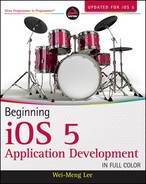SUMMARY
In this chapter, you learned how you can easily integrate the various built-in applications into your own iPhone applications. In particular, you saw how you can invoke the built-in SMS, Mail, Safari, and Phone simply by using a URL string. In addition, you learned how to send SMS and e-mail messages without leaving your application. You also learned about accessing the Photo Library applications using the classes provided by the iPhone SDK.
EXERCISES
- Name the various URL strings for invoking the Safari, Mail, SMS, and Phone applications.
- What is the class name for invoking the Image Picker UI in the iPhone?
- What is the class name for invoking the Mail Composer UI in the iPhone?
- What is the class name for invoking the Message Composer UI in the iPhone?
Answers to the exercises can be found in Appendix D.
![]() WHAT YOU LEARNED IN THIS CHAPTER
WHAT YOU LEARNED IN THIS CHAPTER
| TOPIC | KEY CONCEPTS |
| Sending e-mail from within your application |
NSString *emailString = @“mailto:[email protected]&subject=Subject&body=Body”; [[UIApplication sharedApplication] openURL:[NSURL URLWithString:emailString]]; |
| Invoking Safari |
[[UIApplication sharedApplication] openURL:[NSURL URLWithString: @“http://www.apple.com”]]; |
| Invoking the Phone |
[[UIApplication sharedApplication] openURL:[NSURL URLWithString: @“tel:12345678*2” ]]; |
| Invoking SMS |
[[UIApplication sharedApplication] openURL:[NSURL URLWithString: @“sms:12345678*2” ]]; |
| Accessing the Photo Library | Use the UIImagePickerController class and ensure that your View Controller conforms to the UINavigationControllerDelegate protocol. |
| Invoking the Mail Composer UI | Use the MFMailComposeViewController class. |
| Invoking the Message Composer UI | Use the MFMessageComposeViewController class. |
..................Content has been hidden....................
You can't read the all page of ebook, please click here login for view all page.
